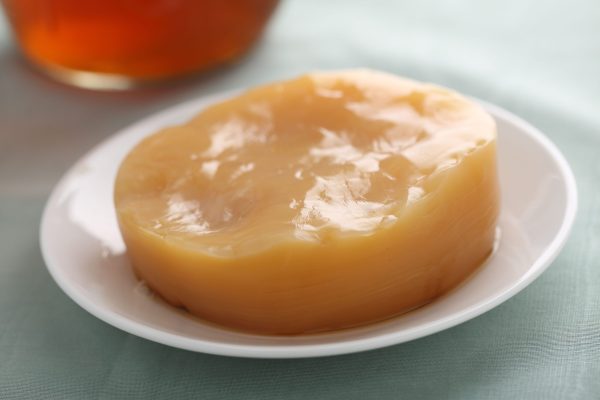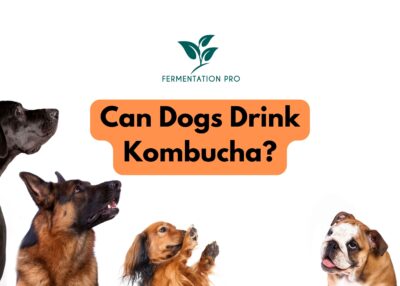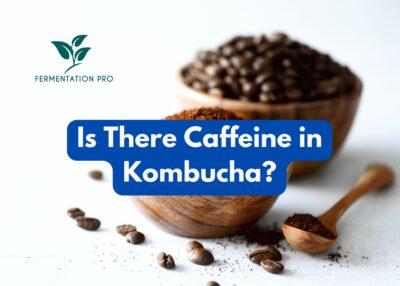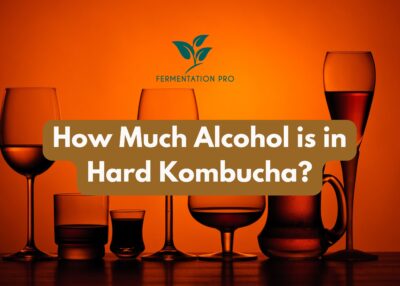Kombucha and mushroom have a surprisingly long and entwined history. Over the years, Kombucha SCOBY has been commonly referred to as mushroom and Kombucha tea as mushroom tea. But is Kombucha really a mushroom
Contrary to popular belief, Kombucha is not a mushroom. The mushroom-looking object in every Kombucha brew that transforms the sweet tea into Kombucha is called a SCOBY. It stands for Symbiotic Colony Of Bacteria and Yeast. Although the yeast in the SCOBY can be considered a fungi like mushroom, we still cannot refer to Kombucha as a mushroom because yeast and mushrooms are biologically different.
Referring to Kombucha as mushroom has been a commonplace through generations so it can be hard to believe that this healthy drink is not made with a body of fungus. If you are still not convinced, here are some science based facts and information proving that Kombucha is not a mushroom at all.
Table of Contents
Is Kombucha a Mushroom?
The short answer is no. Kombucha is often called a mushroom because of the floating object that resembles a mushroom cap inside every Kombucha brewing jar. This mushroom-like object is called the SCOBY and is not related to a mushroom at all.
In fact, it is a cellulose mat or biofilm composed of bacteria and yeast cultures that work together to convert the sweet tea into Kombucha.
The mushroom-like appearance is formed as the bacteria and yeast clump together and grow during the brewing process.
What is Kombucha SCOBY?
A SCOBY is important for Kombucha brewing because it promotes the fermentation of Kombucha. Without a SCOBY, the sweet tea will remain as it is. Like mushrooms, Kombucha SCOBYs can have different shapes and colors, ranging from light to dark brown shades depending on the tea and the SCOBY’s age. SCOBY is also a great source of many nutrients that can help aid in digestion, improve memory and immune system, lower high blood pressure, and more.

Although yeast and mushrooms belong to the Kingdom Fungi, a Kombucha SCOBY can’t still be compared to mushrooms.
First of all, the yeast in the SCOBY is not the same as a mushroom biologically. Yeast is a fungus that grows as a single cell while mushrooms grow as a multicellular fungus.
In addition to the difference in the yeast and mushroom structures, their functions and uses are also different. Yeast like the Saccharomyces cerevisiae, which is found in Kombucha, is used for brewing alcoholic beverages and baking bread. On the other hand, a mushroom is a fruiting body of a fungus often used for cooking.
The environment and safety of yeasts and mushrooms vary as well. Yeasts are found everywhere in nature like plants and fruits and most yeast varieties are considered harmless to the body as long as they are consumed in small to moderate amounts. Mushrooms mostly live underground in damp and dark places or in decaying plant matter like tree trunks or branches. Although mushrooms are proven healthy and many enjoy their delicious taste, some mushrooms are poisonous even in small amounts. Hence, it is not advisable to gather and eat wild mushrooms.
kombuchakamp.com defines the relationship of mushroom and yeast as distant cousins rather than brothers. So, even though all mushrooms are fungi, not all fungi are mushrooms.
What Kind of Mushroom Is Used in Kombucha?
There is no mushroom used in Kombucha. The object that seems to resemble a mushroom in a Kombucha brewing jar is called a SCOBY. It is a colony of bacteria and yeast living together in symbiosis to transform sweet tea into tangy and sweet Kombucha.
While Kombucha is not related to mushrooms, that doesn’t mean that you can’t add mushrooms to this healthy drink. Kombucha is a flexible drink that allows you to adjust its flavor and taste. You can add different flavorings like fruits, vegetables, herbs, spices, and even mushrooms.

Mushrooms are packed with health-promoting substances. They contain vitamins, minerals, and antioxidants that can lower blood pressure, boost the immune system, aid in weight loss, and lessen the risk of different diseases like Alzheimer’s disease, cancer, and diabetes. Adding mushrooms to your Kombucha brew may allow you to get the same benefits as eating mushrooms.
So what kind of mushroom can you add in Kombucha? You can pretty much use all kinds of edible mushrooms for your Kombucha. For instance, smithymushrooms.com likes to use all varieties of oyster mushrooms which are mushrooms commonly cultivated in Germany. On the other hand, mushrooms 4life.com has another way of incorporating mushrooms in Kombucha. In their blog, they suggested adding mushroom powders or supplements for more convenience.
Is Kombucha Culture Fungus?
Kombucha is a healthy drink formed with a biofilm of bacteria and yeast called SCOBY. The bacteria in the Kombucha are classified as probiotics and not fungus. However, the yeast in Kombucha belongs in the same kingdom as fungus which is the Kingdom Fungi. Despite this, we still cannot say that the Kombucha culture is a fungus.
According to pediaa.com, fungi and yeast are closely related organisms but are different when it comes to structure, habitat, appearance, uses, and more. The main difference between yeast and fungus is their structure. The yeast is a unicellular and rounded-shape organism whereas fungi are multicellular organisms with filamentous hyphae. Because yeasts are unicellular, they are considered unique in the kingdom fungi
Why Is Kombucha Called Mushroom Tea?
We often hear people classifying Kombucha as a mushroom. In fact, some of the many names of Kombucha culture and Kombucha tea are after this body of fungus. For instance, the kombucha culture, also called the SCOBY, is often referred to as Kombucha Mushroom and Manchurian mushroom. On the other hand, Kombucha tea is called mushroom tea.
Throughout the course of Kombucha history, this healthy drink has been called mushroom tea because of the SCOBY inside the Kombucha brew which looks like a mushroom. The SCOBY is responsible for turning the sweet tea into Kombucha. While it does look like a mushroom, biologically, a SCOBY can’t be classified as one.
Mushroom tea is just one of the many names that has been used to call Kombucha. During the early years of Kombucha in China. It has been referred to as Sea Mushroom along with its other ancient names which are Sea Treasure and Stomach Treasure. As Kombucha rose to popularity, more names like red tea bacteria/fungus/yeast, red tea mushroom, and tea mold were used to refer to this health-promoting beverage.
Below, we share with you some of the other popular names of Kombucha today.
- Miracle Fungus
- Magical Fungus
- Elixir of Life
- Gout Tea
- Russian Fungus
- Champagne of Life
- Japanese Fungus / Sponge
- Medusa Tea
- Miracle Mushroom
- Tea fungus / Fungus Tea
- Magic Mushroom
- Tea Plant / Beast
Who Shouldn’t Drink Kombucha?
According to healthline.com, people with weakened immune systems due to certain diseases like cancer, kidney disease, and HIV can experience complications from drinking Kombucha. Pregnant and breastfeeding women should also avoid drinking Kombucha because of its caffeine and alcohol content that can cause adverse health effects to their baby.

If you have digestive issues like Gastroesophageal reflux disease (GERD), you may want to avoid drinking Kombucha as well. Drinking Kombucha can increase the severity of the symptoms of this disease. Moreover, Kombucha contains small amounts of caffeine and alcohol. Although these amounts are not enough to affect your body, you may still want to consider these substances before drinking Kombucha especially if you are sensitive to them.
Homebrewed Kombucha may not also be suitable for kids aged 4 and older because it tends to have a higher alcohol percentage. Additionally, Kombucha brewed at home is unpasteurized which means that it didn’t undergo a process of sterilization. Because of this, it may contain different types of bacteria and varieties of yeasts that can promote the growth and development of opportunistic bacteria. When opportunistic bacteria enter the body, it can lead to infections. However, if you really want to give your child Kombucha, it would be better to give them commercial or store bought Kombucha because they have less alcohol content and have undergone sterilization processes.
Is Kombucha Safe?
Kombucha is considered safe for most people however it can cause adverse side effects in some especially when it is consumed in large amounts or more than the recommended amount of daily consumption. As a general rule, you shouldn’t consume more than 12 oz. of Kombucha in a day. Other side effects of Kombucha may also be caused by the acid, alcohol, and caffeine in this drink.
Nevertheless, if you are a generally healthy individual, you shouldn’t be scared of Kombucha side effects because they rarely occur as long as you don’t drink too much Kombucha in a day. The acidity of Kombucha also makes it less prone for contamination and bad bacteria growth whether it’s commercially produced or homebrewed.
If you are still not sure whether you can drink Kombucha or not, we highly recommend consulting your doctor first especially if you have preexisting health conditions. Consulting your doctor will give you proper knowledge on how to drink Kombucha properly and safely depending on the state of your health.








